
|
From The President:
I was out there in my garden, moving the astilbe to cover the foundation
of the garage, arranging the rocks so they'll 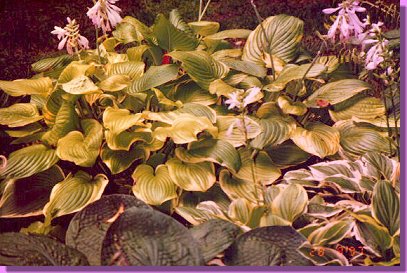 peak
through the hosta leaves, deciding which heuchera works best. Then, it
hit me that WNYHS is like a garden. All the members want to work together
to make one attractive organization with its own personality. At the same
time, the individuals which comprise the group have special needs which
must be cultivated. Some folks show their pride in their garden by naming
it. WNYHS has a logo naming us, which we'll wear with pride. peak
through the hosta leaves, deciding which heuchera works best. Then, it
hit me that WNYHS is like a garden. All the members want to work together
to make one attractive organization with its own personality. At the same
time, the individuals which comprise the group have special needs which
must be cultivated. Some folks show their pride in their garden by naming
it. WNYHS has a logo naming us, which we'll wear with pride.
The WNYHS Member Survey showed that the most important reason that
you joined the Society is to meet and talk to people about hosta. Additionally,
you want to expand your gardening skills and your collection of hosta.
So, have we got activities for you! You already received the
calendar, and you will receive postcard reminders of events where we can
both gather AND learn about hosta. This newsletter has details of the continuing
special programs we're embarking upon.
First, the Seed Exchange, chaired by Ran Lydell, will be launched this
fall with an auction of seeds. Ran will talk about hybridizing goals and
seed growing at the November 16, 1997, Anniversary Party, at 2PM at the
Botanical Gardens.
Next, the Hosta Acquisition Program, chaired by Wes Hyde, will be taking
applications. We will depend upon proceeds from our Public Sale on July
19, 1998, for funds.
The third special program is the Challenge Hosta Program which will
allow each member to acquire, grow, exhibit H. 'Patriot' and compete for
a prize at the Cut Leaf Show next June.
Fall is a time of reflecting on AND for renewing the garden. After
a very busy Spring and Summer, let's pay lots of attention to the details
and get those hosta sited just right so they'll show off at their best
next spring! Please call or write any WNYHS Board member with your comments
and suggestions, and especially to volunteer your time and growing expertise
about hosta.
Carolyn Schaffner
WNYHS President

|
Welcome to the third edition of
HOSTA La Vista.
Published quarterly by the
Western New York Hosta Society
NEWSLETTER DEADLINE
FOR THE NEXT ISSUE: Nov. 15
Editor: Rachel Martin
Submissions and comments can be
e-mailed to me at:
hosta@gardener.com
|

 Editors
note: Editors
note:
The Hosta E-Mail Robin is a valuable tool for
all gardeners. Plus, I use it as a resource for our newsletter!!
 THE SLUG COLUMN
Mulch (and Slugs)
by Butch Ragland.
THE SLUG COLUMN
Mulch (and Slugs)
by Butch Ragland.
Our commercial business is mulch production for the retail and landscape
industry so I use lots of mulch and it doesn't matter what you use for
mulch. We've have not experienced any problem with slugs.
At the first sign of slug damage I put straight vinegar in a hose-end
sprayer, full strength, and spray all around the hosta and do that each
time I see any indication of slugs.
Slugs aren't attracted to mulch. They are attracted to a food source.
If slugs come to the edge of a mulched bed and find nothing to eat, then
on they go off merrily looking food. They will move until they find food,
then look for a spot to get out of the sun under the food source.
When they find your hosta, KILL the little buggers soon with vinegar.
Vinegar will not kill or hurt your plants in any way. Its not necessary
to be careful how you mix the vinegar. Spray 2 times per week until you
cannot find fresh slug damage.
I wouldn't use cedar mulch but have used about 4 inches of hardwood
mulch on top of TC plants which causes them to come up late and miss late
spring freezes.

 Editors
notes: Editors
notes:
For me there is more to gardening than Hosta !!! I enjoy visiting gardens
and looking for garden ornaments. I even thrive on making the organization
work ~ from doing displays, to stuffing envelopes & sending info to
people who say they want to know more about our group.
So I have added some of these elements into your newsletter!! This
issue has two garden reviews, one of a local member and one from a well
known hosta grower. If you go to a great garden and would like to write
a review, please go for it! I think the small gardens need to be visited
and written about too.
One of the programs in the works for WNYHS is a GARDEN TOUR. Members
who want their garden to be involved should check this newsletter for instructions.
More SEED EXCHANGE and ACQUISITION PROGRAM information is also here.
Plans are underway for many activities that will excite you. Please
check both your newsletter and mailbox for details of the events from the
WNYHS calendar as they come up so you will not miss anything.
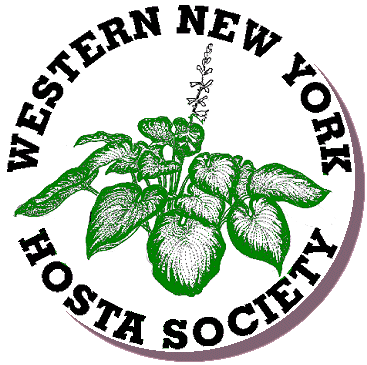 Hope you'll
join us on the van trip to meet with the Pittsburgh hosta lovers on November
1. Hope you'll
join us on the van trip to meet with the Pittsburgh hosta lovers on November
1.
Rachel
P.S. See our new Logo, do you love it? We really are for real now. It
was drawn especially for WESTERN NEW YORK HOSTA SOCIETY by Rich Haynes.
Some may have seen his work elsewhere, since he designed the Buffalo Area
Daylily Society logo too. We are planning T-Shirts, plaques and much more,
stay tuned!!

|
Remember the quote from the Journal a few years hack?
The 1st year they sleep; the 2nd year they creep;
the 3rd year they LEAP
Thanks for reminding us of this. Dale Frank in Minneapolis.
|
 Attention !!!!
Members of the WNY Hosta Society
Attention !!!!
Members of the WNY Hosta Society
Here's the scoop: it's called The Challenge Hosta Project. This is a
chance for you to participate in WNYHS's Cut Leaf Show on the first Sunday
in July, 1998 and bring an exhibit or two. It's also an opportunity for
EVERYONE, even those who feel they aren't yet ready, to compete in all
the divisions. The show will have a special division for this Challenge
Hosta and a special local award for it.
Members become a participant by buying and growing this hosta to perfection,
with the target of showing it in WNYHS's cut leaf show AND by registering
as a participant at a cost of $10.00 per person.
The proceeds will fund awards at the WNYHS Cut
Leaf Show
This project should be a lot of fun, and put emphasis on techniques of
growing to Cut Leaf Show quality. All questions about hosta cultivation,
environmental matters and preparing a specimen for the show that arise
will be answered at our meetings.
So ? Suggestions were made and a "Challenge Hosta" has been chosen.
This hosta is a proven good grower in the Western New York area, with our
winters and summers. It's a little bit of a challenge, but not too much,
this being our first time around and all. It is a hosta that is affordable
by all. And shows itself well....
The Challenge Hosta is
..
..
THANKS SO MUCH!! The Challenge is on!!!
Carolyn Schaffner -- WNYHS President.
 WNYHS Seed Exchange
WNYHS Seed Exchange
Collect seeds from your hosta on a dry day when the seed pods are dry
and cracked open just a bit. Cut the scape and put it top down into a paper
bag, so that the seeds will fall to the bottom. Write on the bag, the parent,
(or parents, if known) hosta's color, height and special features to help
you form a good description later.
Clean the seeds as much as possible, by separating the debris from
the seeds. Package the seed in well sealed paper or cellophane (not plastic)
envelopes such as coin or stamp envelopes. Write the description on the
outside.
Keep a list of the seeds you offer. Make a "wish list" of hosta you
hope someone else will offer. Please bring your envelopes to the November
16 meeting, Anniversary Party, Seed Exchange and Auction. We will
also have seeds from other hybridizers to auction. (Don't forget your checkbook!).

|
The Western New York Hosta
Society
One year membership $10.00
single or family.
$5.00 / additional years.
Send check Payable to WNYHS
to Rachel Martin
248 Bedford Ave, Buffalo, NY
14216.
|
 The Marchard Horticultural Conference
The Marchard Horticultural Conference
The first Marchard Horticulture Conference was held June 21 and 22 at
the Buffalo Museum of Science. The two day conference consisted of 10 lectures
and several smaller workshops on topics from keeping a garden journal to
seed germinaton to iandscaping for birds.
The highlignt of the first day was an entertaining lecture by Beatrice
Elye on seed germination. For successful seed germination it is necessary
to understand the pattern in which the seeds germinate in their natural
environment and to try and duplicate those conditions. In some cases various
types of pretreatment may be necessary. This can indude simply rinsing
the seeds to remove inhibitors, abrading or pricking a seed with a thick
seed coat (fine sand paper or a heavy duty needle work) or treatment with
gibberellic acid. Patterns of temperature and light must also be considered.
For serious seed starters, "Seed Germination Theory and Practice" by Norman
Deno is an excellent source for the requirements of thousands of varieties
ot seeds.
Other lectures discussed various plants recommended for different purposes.
Gardens designed to attract birds must develop many layers, since birds
often eat, nest and sing at differing heights. Also necessary are trees
and shrubs that provide food during the different migration times, spring
and fall. Trees such as Flowering Dogwood, Hawthorn, Mountain Ash or Crabapple
as well as various types of Viburnum provide fruit for the migration journey.
Developing edge plantings that provide shelter also help to attract vanous
birds.
Stretching the garden season is possible by using a selection of early
and late season bloomers. Among the earliest are various trees and shrubs.
Witchhazel, dwarf Viburnum and hardy Magnolias such as Magnolia salicifolia
will help to hurry spring along. Bulbs such as Crocus, Iris reticulata
and danfordii, Scilla siberica (blue squill), Chionoxia ans Puschkinia
scilloides(striped squill) and woodland plants Trillium and Erythronium
are wonderful easy flowers. To extend the season, planting various Heucheras
with their different foliage patterns adds interest. Other possibilities
indude Lycoris squamigera (hardy Amaryllis), Rudbeckias, Sedum, Artemisia.
Ornamental grasses and cabbages to add varieties of color and texture to
the garden. Shrubs and trees to be considered indude Mountain Ash, Viburnum,
Callicarpa and various llex.
For anyone interested I'd be happy to provide a more complete listing
of recommended plants as well as trees and shrubs that maintain a muti-season
appeal.
 Joanne Pyszczek
attended the conference on behalf of WNYHS with a scholarship from the
Museum. Joanne Pyszczek
attended the conference on behalf of WNYHS with a scholarship from the
Museum.
 HOSTA SITTER ACQUISITION
PROGRAM.
HOSTA SITTER ACQUISITION
PROGRAM.
Please join us in this new exciting program To apply, send a note to
Wes Hyde, describing your garden and your garden techniques, the number
and the names of some of the hosta you currently grow. Also enclose a picture
or two to illustrate and to show as much of your garden as you can.
We'll ask you to sign an agreement that says that you'll take good
care of the hosta, return all the fans for distribution to WNYHS, and keep
us informed of the behavior of the plant. In appreciation for your time
and effort, when you return the plant, you will be offered a fan to keep.
 GARDEN REVIEWS.
GARDEN REVIEWS.
I visited Shirley Magee's garden with my two boys, 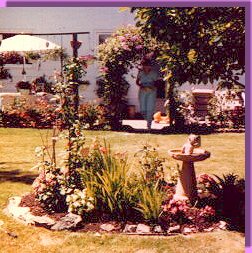 and
found it was a quiet haven, about 15 minutes from my home in North Buffalo.
We parked in the driveway and walked to the rear of the house. On the way
we stopped to see the enormous tomato plants. So large, said Shirley, from
the chicken manure she bought at the Botanical Garden's Rare and Unusual
plant sale. and
found it was a quiet haven, about 15 minutes from my home in North Buffalo.
We parked in the driveway and walked to the rear of the house. On the way
we stopped to see the enormous tomato plants. So large, said Shirley, from
the chicken manure she bought at the Botanical Garden's Rare and Unusual
plant sale.
Then we passed under a trellis covered with a dark blue clematis. WOW!
Every thing was covered with plant life of every kind, all in full bloom
and full of color. Every inch of space is used. Containers are placed around
with plants that need to be brought in over the winter, or to be given
to friends.
Shirley and her husband enjoy morning coffee and cocktails by night
next to their fish pond, which is lit with white Christmas lights to attract
the fire flies. They put on quite a show.
The Hosta 'Elegans' and some Elephant Ears are a wonderful hack drop
to smaller area of specialty shade plants and young hosta. Another spectacular
focal area of the garden is a sunny raised bed of hybrid roses.
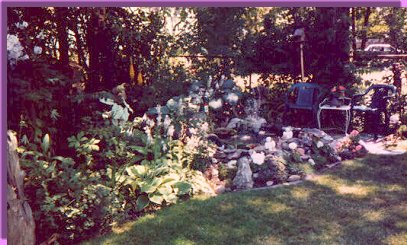 The highlight
of the visit for my older son was finding a large caterpillar which Shirley
kindly put into an old glass fish tank. What a prize for my budding nature
buff!! The highlight
of the visit for my older son was finding a large caterpillar which Shirley
kindly put into an old glass fish tank. What a prize for my budding nature
buff!!
Shirley is a new WNY Hosta member and a very active gardener.
Rachel Martin
Pittsburgh's Barbara Dittmer's tumbling hosta waterfall garden is a
traffic-stopper!! Kevin Walek's hosta waterfall,  which
he says was created quite accidentally is similar. We saw slides of his
wonderful creation during his visit last fall. which
he says was created quite accidentally is similar. We saw slides of his
wonderful creation during his visit last fall.
As you go down the side of the Dittmer's house, under a huge tree,
maybe an oak, on the slope leading to the street are the hosta which Barbara
is using to create a waterfall. As I was coming down the slope, looking
at each hosta plant individually, I didn't get the message, but looking
back, I was struck!
At the top is a huge blue, then, a third of the way down is a smaller
one, and further down at the foot, even smaller blues, and in between,
many less blue, some margined and various sized, various shaped, so that,
if you put a length of soft fabric over it, you'd have the bumpy surface
of a waterfall.
The white margins of some of the plants remind us of the surface of
rough waters, and the blues remind us of the water flowing over big rocks
in the waterfall. Down by your feet, near the street, and in the "front"
of the waterfall are many small white-margined plants as would be at the
rocky bottom of the falls.
Every hosta is different. She has used puckered ones, big ones and
small ones!! Here is Barbara's list for her "Hosta Waterfall" :
Feather Boa, Blue Moon, Patrician, Hadspen Hawk, Golden Heart, So Sweet,
Gold Standard, Love Pat, Sun Power, Sagae, sieboldiana Elegans and Green
Sheen. Reflected on the other side bordering the driveway bed by: Haku
Chu Han, Blue Blush, Silver Hearts, Raspberry Sorbet, Calypso, Mary Marie
Ann, American Dream, Lunar Orbit and Mama Mia.
Carolyn Schaffner with consultation
with Barbara Dittmer
|
Collect photos of
YOUR GARDEN
to apply to be on the
WNYHS's
Garden Tour
|
 Please Welcome these
new members to
WNYHS!
Please Welcome these
new members to
WNYHS!
-
Albanese, Umberto
-
Allan, Raffeala
-
Barcy, John
-
Belling, Alice & Louis
-
Bliss, Roslyn
-
Cejka, Mike
-
Cianchetti, Judy
-
Curtain, John
-
Dompkowski, Dr. Judith
-
Figilski, Rita H.
-
Galarneau, Anthony
-
Haremski, Marie
-
Heintz , Ruth E.
-
Hunt, Christine
-
Hutchings, Robert
-
Jennings, Dave
|
-
Lorich, Mary Anne
-
Lutz, Jean
-
Malachowski, Don & Kathy
-
Marshall-Parker, Loretta
-
Menne Nursery Corp.
-
Michalowski, Daniel
-
Nau, Sherry
-
Shanahan, Joe
-
Simmons, Royce
-
Stephan, Mary Lou
-
Tlustos, Lance Jon
-
Tucholski, Judy
-
Wagner, David & Rita
-
Walker, Mary
-
Weissman, Berry
-
Williams, Noreen
-
Zimmermann, Dr. Edward
|
 NOTE:
The date on your address label tells you when your membership expires. NOTE:
The date on your address label tells you when your membership expires.
 The
membership chair is now Rachel Martin. If you are interested in renewing
or in sending a membership application to a friend please let me know. The
membership chair is now Rachel Martin. If you are interested in renewing
or in sending a membership application to a friend please let me know.
 ASK AN EXPERT.
ASK AN EXPERT.
Q?
I have read that grass is so bad for mulch because it can attract slugs.
My neighborhood has never had much of a slug problem and I have never had
any at all. I want to mulch several hundred tissue cultured hosta plants
I recently planted. Is using a thin layer of fresh cut, weed and herbicide
free grass so terrible? What is the potential downside? What is the best
mulch to use for small tissue cultured hosta?
Thanks,
Thomas S. Carson
St. Paul, Minnesota
A. Dear
Thomas:
Your question is a good one. But you must not use any unrotted humus
product directly on your garden. This could be a disaster for small Hosta
plants. Soil bacteria immediately attack any "fresh" organic material placed
in ground contact, and, in the process of "breaking it down", draw "free
"nitrogen. The plants in the areas are likely to become nitrogen starved,
and a lot of bad things can result from that. It is best to have a little
compost pile, or better yet several, you are working on in various stages
of decomposition, and you will always have some ready to use.
Ransom Lydell
Eagle Bay Hosta Gardens


The VAN will take you to the Joint Pittsburgh & WNYHS Meeting
in Meadville, PA. November 1, 1997. Door prizes await-don't miss
out!! *9:30 AM Van leaves Buffalo *12 noon - 1 PM We'll hear @p53@Bill
Zumbar talk on Mini Hosta *1 - 2:30 PM Buffet luncheon. Return the coupon
and call 837-2285 to reserve your van seat.
 Tips on Planting Hosta
Tips on Planting Hosta
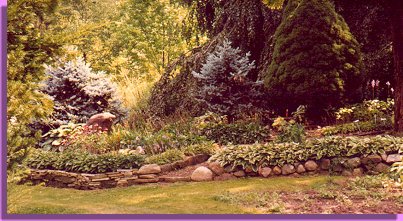 Highly variegated
Hostas that are placed in conditions of too much sun, or in some cases
of too much shade, will frequently start to "compensate" by making
all green "sections". As with all plants, the green parts, because they
are better chlorophyll producers, become dominant, and the variegated parts
will disappear. I have seen this year several 'Paul's Glory' that have
become all green. 'Paul's Glory' (in the north) is quite sun tolerant,
but like most highly variegated Hostas that will grow in the sun, needs
a lot cf moisture! Highly variegated
Hostas that are placed in conditions of too much sun, or in some cases
of too much shade, will frequently start to "compensate" by making
all green "sections". As with all plants, the green parts, because they
are better chlorophyll producers, become dominant, and the variegated parts
will disappear. I have seen this year several 'Paul's Glory' that have
become all green. 'Paul's Glory' (in the north) is quite sun tolerant,
but like most highly variegated Hostas that will grow in the sun, needs
a lot cf moisture!
Ransom Lydell
Eagle Bay Hosta Gardens

|
American
Hosta Society
Robyn Dunback
AHS Membership
7802 NE 63 RD St.
Vancouver, WA 98663
(360) 256-7399
Annual dues: $19.00
The E-mail Robin:
contact:giboshman@aol.com
|
 WHAT TO LOOK FOR
WHAT TO LOOK FOR
Here is something that collectors and hybridizers are looking for: Red
petrioles (the stem part of the leaf). Often, the flower
scape is colorful, too. This list includes some favorite hosta that show
a range of color, from light red to dark purple.
-
Cinnamon Sticks
-
Chopsticks
-
Old Faithful
-
Purple Passion
-
Red October
-
Regal Rhubarb
-
Garnet Prince
-
Ewa Yata Moto
|
-
rupifraga
-
longipes Golden Dwarf
-
longipes var. latifolia
-
Leather Strap
-
Peedee Gold Flash
-
Yellow Waves
-
Hirao Majesty
|
-
Cherry Berry
-
Maraschino Cherry
-
Phantom
-
Black Foot
-
Red Wings
-
Red Sox
-
Tentacles
-
Torch Light
|
(Can you name some more?)


 Editor:
Rachel Martin Editor:
Rachel Martin
hosta@gardener.com
WNYHS officers
President : Carolyn Schaffner
Vice President: Peter Adragna
Secretary: Joanne Pyszczek
Treasurer: Dolores Galbo
Board of Directors:
Kathy Guest
Wesley Hyde
Ransom Lydell
Rachel Martin |

  ewsletter ewsletter  vents vents  inks inks

|